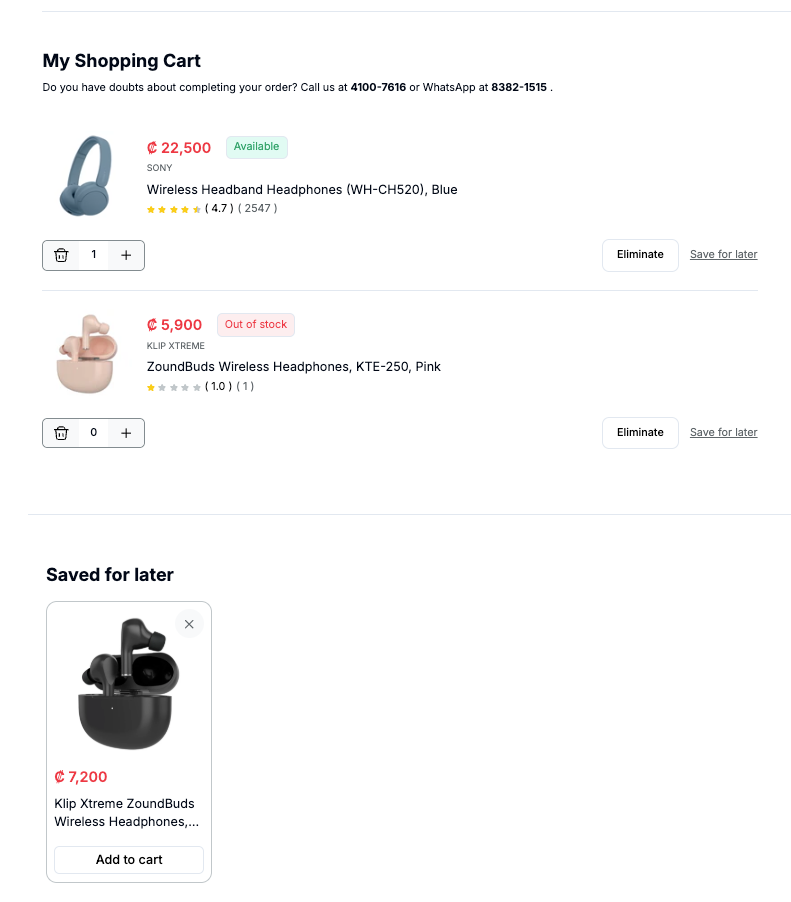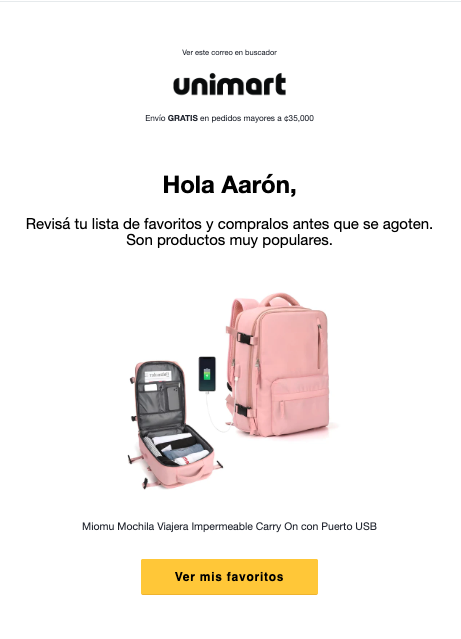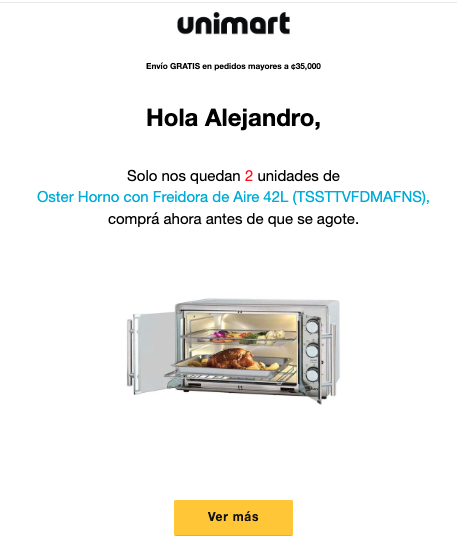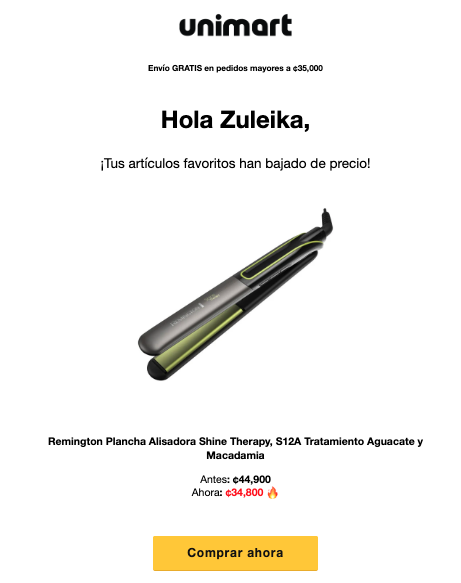

%20(1)%20(1).jpg)
A growing share of lifecycle revenue driven by advanced Wishlist flows.
Unimart is a large, multi-category ecommerce market serving thousands of products across diverse sectors, including apparel, tech, home goods, and more. Its mission: make shopping simple and convenient. It’s important to Unimart that its customers can discover, save, and purchase their favorite products at their own pace. Customers can use Unimart to stock up on essentials, hunt for new deals, or curate wish lists for special occasions.
However, casting a wide net means providing a diverse customer base with a catalog of options. That means many challenges familiar to ecommerce marketplaces, especially using personalized shopping experiences to turn casual browsers into loyal customers. For Unimart, embracing this challenge means giving customers a “save it for later” experience that encourages them to keep visiting the website, purchase across multiple categories, and provide Unimart with shopper intent data to personalize its marketing.
Unimart’s customers often come to the site looking to browse through multiple categories. With multiple categories comes a nearly infinite variety of customer intentions. Short-term impulse buys, long-term “dream” wishlists, stocking up on everyday items—every style of customer intent needed to fit under the Unimart approach to personalized shopping.
Specifically, Unimart wanted to build a wishlist experience with key objectives in mind. First, they needed to encourage customers to return and complete purchases. A wishlist without an eventual purchase might drive some user intent data, but it didn’t ultimately convert into revenue. Second, they needed to drive larger order sizes by nudging customers towards cross-category purchases. And finally, if Unimart could accomplish both goals while gleaning actionable customer intent data for its marketing team, the brand could create the more personalized shopping experience it was after.
As things stood, Unimart needed more than a simple “save-for-later” button.
We did not have a way for our customers to save their future purchases, or create wishlists to share with others for gifting, which resulted in a missed conversion opportunity.
Head of Marketing and Merchandising at Unimart.com
Unimart implemented Swym Wishlist Plus to build a wishlist capable of handling a multi-category shopping journey. Customer intent for Unimart includes everything from impulse buys and gift planning to everyday stocking up. Solving this required a multi-layered engagement strategy beyond a simple “save” button.
Customers could now create multiple lists (“Holiday Gifts,” “Daily Essentials,” etc.) rather than one generic list of liked items. Using Swym’s REST APIs made it fast and seamless to incorporate this right into Shopify’s infrastructure.
Customers became free to build wishlists with their own intents in mind. Impulse shoppers could go straight from saving to buying—which boosted conversions. And Unimart had richer intent data because they could view which kinds of lists tended to match with which products.

Because “save for later” is a separate feature in shopping carts and not another wishlist item, customers could pause their purchases at the point of checkout without losing track of their products. This meant Unimart could retarget specific purchases differently than they would using wishlist data.
Since one of Unimart’s chief challenges was turning browsers into buyers, capturing more checkout drop-offs was an easy win. That’s why ~10% of the improved revenue came from save-for-later products. Additionally, shoppers never felt forced to buy now; they simply stayed in the funnel, ready to purchase at a later time.

Unimart also integrated a set of automated flows to nudge customers in the right direction, including product reminders, back-in-stock alerts, low-stock alerts, and price drop recaps. Open rates on Wishlist alerts were as high as 13.70%. Each flow customized the right messaging to the right customers, creating a more personalized shopping experience.



The result was enhanced urgency and relevance for every product message. Customers were engaged based on personal shopping history, not sitewide purchasing behaviors. Wishlist Reminders alone drove over 60% of the wishlist flow revenue, proving how effective the new workflows could be.
“Our goal was to have another way to remind our customers about the products they're interested in which is a form of retargeting and a good way to drive engagement through personalized content.”
Over the past four years, Unimart’s wishlist program has gone from an added feature to a fully grown cornerstone of its lifecycle marketing features. The numbers speak for themselves:
Momentum only seems to be accelerating. These days, Winback and Price Drop Recap features are outperforming the classic Wishlist Reminder flows, which signals that Unimart’s advanced retargeting tactics are making good use of the data these wishlists provide. In short, Unimart is using Wishlist Plus to drive more customer features while using its data to drive improved personalization decisions for its team.
The wishlist program has also changed how Unimart thinks about customer engagement. They’ve turned shopper intent data into relevant and low-pressure nudges, which is leading to an overall experience that customers appreciate.
The results are real. Now, it's your turn to grow customer engagement and boost your store's revenue.

“Wishlist winback reminders alerting price drops on a wishlist item have performed extremely well. It's a great feature that keeps our customers engaged and allows us to store additional data about our customers' interests so we can personalize our messaging even more.”Adriana Pulido
Co-founder, Head of Marketing and Merchandising at Unimart.com
 How Swym apps help Brighton boost AOV and LTV
How Swym apps help Brighton boost AOV and LTVBrighton, a 30+ year leading manufacturer, retailer, and wholesaler of jewelry, handbags, American-made leather goods, and accessories, was an early arrival to the world of online sales.
Read Case Study Can a Wishlist Be as Distinctive as the Brand Behind It?
Can a Wishlist Be as Distinctive as the Brand Behind It?Luxury womenswear brand LaPointe was looking for a wishlist as intentional and chic as its unique designs. Partnering with Driver Digital, they used Swym’s flexible SDK and API features to create a fully integrated wishlist for a uniquely fresh, luxurious shopping experience—and did it all without the complexity of starting from scratch.
Read Case Study